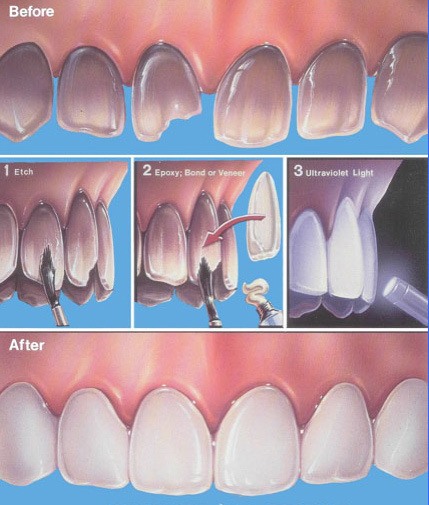
Dental veneers, made of porcelain or composite resin, offer a long-lasting solution for enhancing your teeth and can endure for years with proper care. How are veneers fitted to teeth-the process of fitting dental veneers is a multi-step journey towards achieving a flawless and natural-looking smile. It begins with an initial consultation with your dentist, during which your oral health is assessed and your desired outcome is discussed. Impressions of your teeth are taken to create custom-made veneers tailored to your unique smile. The next step involves the painless removal of a thin layer of enamel to make room for the veneers. Subsequently, the veneers are bonded to your teeth using a specialized dental adhesive, with necessary adjustments made to ensure an ideal fit and appearance. The result is a stunning, natural-looking smile. Dental veneers, made of porcelain or composite resin, offer a long-lasting solution for enhancing your teeth and can endure for years with proper care.
How Are Veneers Fitted to Teeth?
Dental veneers are a popular cosmetic dentistry treatment that can transform the appearance of your smile. But how exactly are dental veneers fitted? In this article, we will walk you through the process of getting dental veneers and what you can expect during each step.
Step 1: Consultation and Examination
- Schedule a consultation with your dentist to determine your eligibility for dental veneers.
- During the appointment, your dentist assesses your teeth, discusses your goals, takes X-rays and impressions, and formulates a personalized treatment plan.
- You’ll also discuss material options, costs, required visits, and potential risks.
The Benefits of Dental Veneers
- Veneers can significantly enhance your smile’s aesthetics by addressing stains, chips, cracks, gaps, and misalignment.
- They improve tooth shape and size, providing a more symmetrical and harmonious appearance.
- Unlike crowns, veneers are minimally invasive, preserving natural tooth structure.
Step 2: Tooth Preparation
- After deciding on veneers, the next step involves tooth preparation.
- Your dentist removes a thin layer of enamel from the front of your teeth to create space for veneers.
- Impressions are taken and sent to a dental laboratory for custom veneer fabrication, while you may receive temporary veneers.
Temporary Veneers: What to Expect
- Temporary veneers, typically made from acrylic or composite resin, serve as previews and protect your teeth while awaiting permanent veneers.
- Handle them with care; avoid hard or sticky foods and gentle brushing and flossing.
- If temporary veneers loosen or break, consult your dentist for guidance.
Step 3: Veneer Placement
- In the final step, your custom-made veneers are placed.
- Temporary veneers are removed, teeth cleaned, and permanent veneers tried on for fit adjustments.
- Your dentist bonds the veneers with special adhesive, hardening it with a curing light, and finally polishes them for a seamless blend with your natural teeth.
Tips for Maintaining Dental Veneers
- Maintain good oral hygiene by brushing twice daily and daily flossing.
- Avoid biting into hard objects to prevent veneer damage.
- Limit consumption of staining foods and drinks like coffee, tea, and red wine.
- Use a mouthguard for sports or teeth grinding.
- Regularly visit your dentist for check-ups and professional cleanings to ensure veneer longevity and a beautiful smile.
In conclusion, dental veneers are fitted through a multi-step process that involves consultation, tooth preparation, and veneer placement. These thin shells of porcelain or composite resin can transform the appearance of your smile by correcting various dental imperfections. By following proper oral hygiene practices and taking necessary precautions, you can enjoy the benefits of dental veneers for many years to come.
Key Takeaways: How Are Veneers Fitted to Teeth?
- Dental veneers are thin shells made of porcelain or composite resin that are custom-made to fit over the front surface of teeth.
- The process starts with a consultation with a dentist to determine if veneers are the right option for you.
- The dentist will then prepare the teeth by removing a small amount of enamel to ensure a proper fit for the veneers.
- An impression of your teeth will be taken and sent to a dental laboratory where the veneers will be fabricated.
- Once the veneers are ready, the dentist will bond them to your teeth using a special adhesive, and make any necessary adjustments for a comfortable fit.
Frequently Asked Questions
What is the process of fitting dental veneers?
The process of fitting dental veneers involves an initial examination, enamel removal, and impressions for custom veneers. Temporary veneers may be used to protect your teeth. Custom veneers are checked for fit and appearance before bonding with dental adhesive, followed by hardening with a special light. Excess material is removed, and adjustments are made for a comfortable and natural look.
How long does the process of fitting dental veneers take?
The time required for fitting dental veneers can vary due to factors like the number of veneers, case complexity, and techniques used. Typically, it involves two to three visits: a one-hour consultation and a two-to-three-hour veneer placement appointment. The actual timeline may vary based on individual circumstances and any necessary preliminary treatments, such as teeth whitening or orthodontic work.
Are dental veneers a permanent solution?
Dental veneers are a durable but not permanent solution for enhancing teeth appearance, typically lasting 10 to 15 years when well-maintained. To extend their lifespan, practice proper oral hygiene, attend regular check-ups, and refrain from harmful habits like biting hard objects or using teeth as tools.
Do dental veneers require any special care?
Maintaining dental veneers involves daily brushing with non-abrasive toothpaste, daily flossing, and using mouthwash. Stain-resistant veneers benefit from avoiding excessive consumption of teeth-staining foods and drinks. A nightguard may be recommended for teeth grinders. Regular dentist visits and oral hygiene are key to preserving veneer longevity and aesthetics.
Can dental veneers fix all dental issues?
Dental veneers are a versatile cosmetic solution for discolored, stained, chipped, cracked, or misaligned teeth, as well as closing gaps and enhancing overall smile symmetry. However, suitability varies, and your dentist will recommend the best treatment, which may include dental crowns, orthodontics, or teeth whitening in some cases.
Dental Veneers Procedure Explained
Final Summary: How Are Veneers Fitted to Teeth?
The process of obtaining dental veneers involves a thorough examination by a dentist, followed by personalized treatment planning. Initially, a small amount of enamel is removed from the teeth to create space for the veneers, and impressions are taken. Temporary veneers may be used while custom veneers are being fabricated. The final step is bonding the veneers to the teeth using strong adhesive, with necessary adjustments made to achieve the desired shape and color.
Dental veneers provide a long-lasting solution for enhancing your smile and boosting confidence. Regular oral hygiene practices and dental check-ups are crucial for maintaining these investments. This transformative journey empowers individuals with radiant smiles, and consulting a qualified dentist is essential for those considering veneers. This comprehensive overview ensures you’re well-prepared to take the step toward a brighter, more confident smile.
Call or Book appointment online
:Ace Dental Care Alpharetta office: 678-562-1555 - Book Now
Ace Dental Care Norcross office: 770-806-1255 - Book Now
Disclaimer
This blog post was generated by artificial intelligence. The content of this post may not be accurate or complete, and should not be relied upon as a substitute for professional advice. If you have any questions about the content of this post, please contact us.
We are constantly working to improve the accuracy and quality of our AI-generated content. However, there may still be errors or inaccuracies. We apologize for any inconvenience this may cause.





